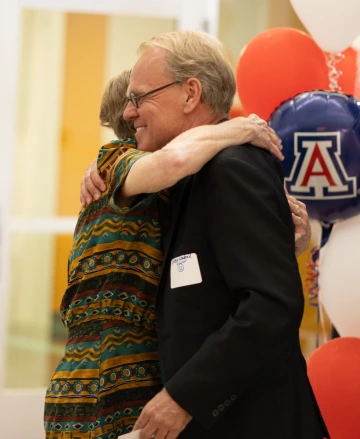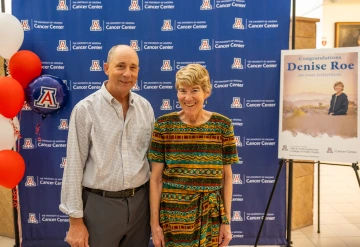Denise Roe: mentor, prolific biostatistician and leader
A career retrospective on nearly four decades of influence on cancer research through biostatistics and informatics

With biostatistical contributions in more than 230 refereed journal articles, Denise Roe, DrPH, has impacted almost all aspects of cancer research produced in the U of A Cancer Center during her prolific tenure.
Over the years, Roe has worn many hats, with titles that include: director of the U of A Cancer Center (UACC) biostatistics and bioinformatics shared resource; professor in the U of A Mel and Enid Zuckerman College of Public Health; and professor of statistics in the U of A Graduate Interdisciplinary Program in Statistics and Data Science.
Yet, Roe looks back on nearly 40 years at the U of A and considers her most significant accomplishment to be the countless hours she has devoted to her students. In all her endeavors, she has taught or mentored about 3,000 future scientists and researchers who are now peppered throughout Arizona and other parts of the U.S.
“They are my contribution to the next generation, and I'm very proud of my students,” Roe said. “In fact, on my biosketch, I have a section about the students that I've mentored, the papers that they've published and what they've gone on to do.”
Often during a trip to the grocery store in Tucson, her former students will greet her and reintroduce themselves, telling her how much her contribution meant to their lives.
“The nice thing is, because I've been here long enough, I've seen junior faculty members grow up into senior faculty members,” Roe said. “That's been very satisfying.”
Bringing together two passions: math and biology

Denise Roe hugs Georg Wondrak, PhD, at Roe's retirement party with balloons in the background.
Roe’s career started with a love for both science and math, earning her undergraduate degree in biology from UCLA with a minor in mathematics.
“I just kept taking math courses because I enjoyed them,” Roe said. “In my senior year as an undergraduate, I realized that I was doing well in biology, but I didn't want to work in the lab, so I looked around and discovered biostatistics.”
She attended the University of Colorado Health Sciences Center in Denver for a master's degree, then returned to UCLA as a master's level statistician working at the Jonsson Comprehensive Cancer Center while completing her doctorate.
During her studies, Roe joined the U of A Cancer Center in August of 1986 as a staff biostatistician. She then became a research assistant professor in family and community medicine before assisting with launching the U of A’s College of Public Health.
Remembering the cancer center’s courageous creators
Roe worked with Sydney Salmon, MD, the cancer center founding director, on his medical oncology program project grant.
“He was very approachable and definitely a brilliant man,” Roe said of Salmon. “It was clear he loved Tucson, and he really wanted an NCI-Designated Comprehensive Cancer Center here.”
When Roe first started at the cancer center, her team worked in a house on Elm Street that has since been torn down. The cancer center administrative offices were in an onsite trailer as the Levy Building was constructed. Staff, researchers and clinicians moved into the new building a year later.
“That was just really exciting,” Roe said. “The clinic was on the first floor, and our biostatistics offices were on the second floor adjacent to administration. I really liked being in that suite of offices.”
One of her favorite memories is that every fall, Salmon had a “We Survived the Summer” party at his house. She said that at that time, the cancer center was small enough that everyone was invited.
“It was a buffet, and he would spend as much time showing us his greenhouse, because he was an avid gardener, as talking about science,” Roe said.” He was an incredible individual, and I'm sure that's why the cancer center got such a great start.”
Roe said different departments quickly filled up all levels of the Levy Building to develop the future renowned comprehensive cancer center.
“At the time, the NCI was not approving any new comprehensive cancer centers, but Syd put the infrastructure in place to develop the programs for the cancer center, including shared resources,” Roe said. “He worked within that model, but then he was very good at recruiting people who would come in with their labs or with their clinical practice and build up the cancer center.”
Roe remembers a time about six months after she started her position when Salmon gave junior faculty $1,000 to buy books, attend a conference or engage in other career-related activities.
“I thought someone had handed me the key to the end of the rainbow because, being a struggling student, you never have enough money to buy the books that you want to,” she said.
Roe still has the books she bought with Salmon’s generous and supportive investment in junior faculty.
After Salmon, she worked with Daniel Von Hoff, MD, now at TGen, as the director for a few years, then David Alberts, MD, became the cancer center director. Sylvan Green, MD, was recruited to be the director of the biostatistics shared resource due to his strong background in clinical trials.

In the early 2000s, Roe assisted with creating the College of Public Health as the associate dean for academic affairs and helped the college with its initial accreditation with Council on Education for Public Health. When Green died in 2008 of pancreatic cancer at the age of 62, Alberts brought Roe back to the cancer center to take over as the head of biostatistics.
“Denise’s contributions to building the Department of Epidemiology and Biostatistics cannot be truly measured,” said Kacey Ernst, PhD, department chair and professor of epidemiology and biostatistics in the Mel & Enid Zuckerman College of Public Health. “From her contributions as an instructor, who students talk about for years after their program as being one of the best teachers they have ever had, to her leadership in developing programs and providing guidance to junior faculty, she has been one of the biggest contributors to our success. For me personally, Denise has been a steady source of wisdom and advice throughout my career from a fresh junior faculty to department head. She is simply irreplaceable.”
Why is biostatistics important to cancer research?
“Humans are great at seeing patterns that they want to see, and what biostatistics asks is whether what we're observing is extreme compared to what we would expect if it's just random noise,” she said.
In explaining biostatistics, Roe said that if a group of patients are treated with a new drug versus a standard drug, they should not all respond the same as the standard. If they do, clearly the new drug is not better.
“How much better does the new drug need to be for us to decide that this is a real signal and not just random variability,” Roe said. “So that's what biostatistics does.”
She said that biostatistics are crucial to all three research programs at the cancer center: cancer biology, cancer prevention and control, and clinical and translational oncology, and Roe works with them all in their studies, clinical trials and programs.
“In essence, I have a toolbox, and the toolbox can be applied in a lot of different settings. It just depends on working with the investigator,” she said. “I've been fortunate to work with a very good team of staff members and other faculty to help support the needs of the cancer center.”
Sherry Chow, PhD, a professor in the U of A College of Medicine – Tucson, and a research associate professor in pharmaceutical sciences and pharmacy practice-science, has worked with Roe for more than 25 years. She said that a common refrain in her team discussions has long been, “Let’s run this by Denise.”
“That simple phrase reflects the deep trust we place in her expertise, as well as our appreciation for her rare ability to translate complex statistical concepts into understandable insights,” Chow said. “Her talent for bridging disciplines has consistently strengthened the rigor and impact of our work.”
Looking backward on progress

From left, Ron Lynch, PhD, and Denise Roe are longtime colleagues who have collaborated extensively during their careers.
Ronald Lynch, PhD, director of the Arizona Research Institute for Biomedical Imaging, associate director of the U of A Comprehensive Cancer Center shared resources and professor in the U of A Departments of Physiology, Pharmacology and Biomedical Engineering, said that Roe has been a vital component of the cancer center for most of its existence.
"She has been a colleague that I have regularly relied upon for expertise, advice and guidance over many years," Lynch said. "She has been a role model for collaborative science by consistently demonstrating a passion for advancing the overall research program at UACC."
Asked about her biggest accomplishments, Roe shifts the spotlight to her colleagues along with her students, and to the privilege she has had to use her biostatistical tools and talents to move cancer exploration forward.
“Working in cancer research has been particularly satisfying,” Roe said. “I've had the opportunity to work with many very astute, dedicated investigators. I'm proud of what I've been able to do in terms of helping them move their research forward.”
When Jennifer Bea, PhD, first began her academic work, she remembers that Roe offered her wisdom, expertise and support to assist the young scientist as she had with many other early stage investigators. Bea is now the cancer center’s Cancer Prevention and Control Program co-leader, Behavioral Measurements and Interventions shared resource director, associate professor of medicine in both the U of A College of Medicine – Tucson and health promotion sciences in the Mel & Enid Zuckerman College of Public Health. She describes Roe as a kind and generous collaborator and teacher who has trained the next generation of statistical leaders and won notable teaching awards in the process.
“I benefited from her statistical consultation early in my academic career. I was a physiology graduate student stuck on a regression problem,” Bea said. “Even though I had never had a class from Dr. Roe or even met her in passing, she graciously scheduled a meeting with me to help me solve my problem. I was struck then, and still today, by her ability to focus entirely on the problem at hand and helping you to solve it.”
Looking toward the future
Over her career, Roe says cancer research progress has been inspiring and frustrating for her. In some cancers, such as childhood and breast cancers, there are vast improvements while others, like pancreatic cancer, have a long way to go.
“What I've seen over the last few years is that we're understanding the basics of cancer much better,” Roe said. “I hope that eventually, that will translate into better therapies because it just seems like the investigators I'm working with now are really homing in on what makes cells metastasize and what causes cancer cells to grow.”
She also sees improvement in cancer prevention and control research, but she sees the greatest challenge as getting people to change their behavior. She also sees vast strides in personalized medicine for cancer treatment.
“There won't be one-size-fits-all clinical studies. They'll be a lot more adaptive,” Roe said. “And we'll go in with knowing more about individual patients and how their therapy should be identified for them. That will help us improve outcomes.”
Roe is grateful for all her colleagues at UACC and the collaborative opportunities she has had. She is optimistic about the future of UACC moving forward.



